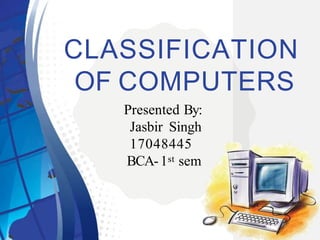
classification od computer types.pptx
- 1. CLASSIFICATION OF COMPUTERS Presented By: Jasbir Singh 17048445 BCA-1st sem
- 2. 1. Introduction 2. Types of computers Digital computers Analog computers Hybrid computers 3. Purpose Wise Classification Special purpose computers General purpose computers 4. Size wise classification Embedded computers Programmable computers Laptops or notebooks Personal computers Workstation Mainframes Super computers INDE X
- 3. INTRODUCTI ON is a Computer programmabl e machin e. The two principa l characteristic s computer of a are: It responds to a specific set of instructions in a well defined manner and it recorded list can execute a pre of instructions (a program).
- 4. DIGITAL COMPUTERS Most commonly used computers are digital computers. They represent data, whether numbers, letters, or symbols, in binary form (i.e. ‘0’ and ‘1’) and they work with numbers in the form of separate discrete digits. ANALOG COMPUTERS Analog is a Greek word that denotes ‘similar’. Analog computers use continuous physical quantities like pressure, temperature, length, voltage etc. and convert them into numeric values.
- 5. HYBRID COMPUTERS Hybrid computers are computers that exhibit features of analog computers and digital computers. The digital component normally serves as the controller and provides logical and numerical operations.
- 6. SPECIAL PURPOSE COMPUTER is designed only to meet the requirements of a particular task or application. It therefore doesn’t posses unnecessary options and is less expensive. GENERAL PURPOSE COMPUTERS are designed to meet the needs of many different applications. The instructions needed to perform a particular task are wired permanently into the internal memory.
- 7. SIZE WISE CLASSIFICATION 1. EMBEDDED COMPUTERS An embedded system is a computer system with a dedicated function within a larger mechanical or electrical system, often with real-time computing constraints. It is embedded as part of a complete device often including hardware and mechanical parts.
- 8. 2. PROGRAMMABLE COMPUTER S These computers are very small but bigger than embedded computers. The main difference between programmable and embedded computers is that the programmable computers can be programmed by users. Example: Personal Digital Assistants ,Tablet PCs, Latest mobiles,etc.
- 9. 3. LAPTOPS AND NOTEBOOKS These computers are much bigger than programmable computers. These computers are placed on your laps. They are designed to mobility to computer users.
- 10. 4. PERSONAL COMPUTERS A personal computer (PC) is a multi- purpose computer whose size, capabilities, and price make it feasible for individual use. PCs are intended to be operated directly by an end user, rather than by a computer expert or technician. Computer time-sharing models that were typically used with larger, more expensive mini computer and mainframe systems, to enable them be used by many people at the same time, are not used with PCs.
- 11. A workstation is a special computer designed for technical or scientific applications. Intended primarily to be used by one person at a time, they are commonly connected to a local area network and run multi user operating systems. It has also been used loosely to refer to everything from a mainframe computer terminal to a PC connected to a network . 5. WORKSTATION
- 12. 6. MAINFRAMES Mainframe computers are computers used primarily by large organizations for critical applications, bulk data processing, such as census, industry and consumer statistics, enterprise resource planning, and transaction processing.
- 13. A supercomputer is a computer with a high level of computing performance compared to a general-purpose computer. Performance of a supercomputer is measured in floating-point operations per second (FLOPS) instead of million instructions per second (MIPS) . 7. SUPERCOMPUTERS